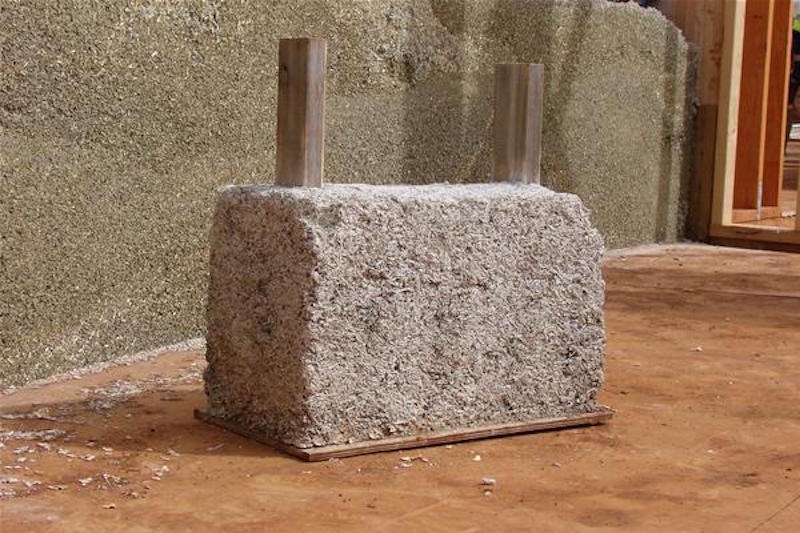Hempcrete
Contents |
[edit] Introduction
Hempcrete, also known as hemplime, is a bio-composite material that can be used in construction as an alternative to materials such as concrete and traditional insulation.
The basis of hempcrete is hemp, the balsa wood-like core (or ‘Shiv’) of a cannabis sativa plant. Hemp can be combined with lime and water to form hempcrete. The hemp has a high silica content, a unique property among natural fibres, which allows it to bind well with the lime. As a lightweight cementitious insulating material, it weighs only one-seventh to one-eighth that of concrete.
Hemp as a building material has been used across Europe for centuries, and as a modern building material, industrial hemp is now grown by certified commercial growers. The strain of plant grown for hempcrete contains 0.3% of THC, the ingredient in cannabis that provides its psychoactive nature. This is compared to the THC content found in hallucinogenic and medicinal varieties of between 5-10%.
While it is legally grown in Europe and Canada, growing hemp in America has been illegal for several decades. However, with the country’s gradual liberalisation of laws regarding the substance for medicinal and personal use, this may change.
[edit] Application
The material is mixed for 1-2 minutes before being applied, either into the wall cavities, or slip-forming with temporary timber or plastic shuttering. A hard render coating is generally applied as a finish on exterior surfaces with a thickness of around 20 mm. The interior can be left 'natural' or, for a traditional aesthetic, finished with lime plaster.
[edit] Properties
Hempcrete is very durable and has a number of other beneficial properties.
Similar to other natural plant products, carbon dioxide is absorbed from the atmosphere by hemp as it grows. During the curing process, as lime turns to limestone, the carbonation of the lime adds to this effect. As a result, hempcrete has a negative carbon footprint, with considerable potential for sustainable building.
It is able to naturally regulate a building’s humidity and temperature, which can reduce condensation and energy consumption, and improve thermal comfort for occupants. It provides natural insulation that is airtight, breathable and flexible. It is also toxin-free, impervious to mould and pests, and highly fire-resistant.
It is very suited to areas at risk of seismic activity since it is a low density material that is resistant to cracking under movement. The outer portion of the plant’s stalk can also provide fibres for building textiles.
However, hempcrete has a typical compressive strength of around 1 MPa, which is around 1/20 that of residential grade concrete, and has a density 15% that of concrete. This means that hempcrete walls must be used together with a load-bearing frame of another material.
[edit] Find out more
[edit] Related articles on Designing Buildings Wiki
- Blockwork.
- Cavity wall insulation.
- Cellular concrete.
- Composites.
- Concrete.
- Could the buildings of the future be made with bones and eggshells?
- Earth building.
- Floor insulation.
- Green building.
- Hemp lime construction: A guide to building with hemp lime composites.
- High alumina cement.
- K-Briq.
- Limecrete.
- Straw bale construction.
- Sustainability.
- Thermal insulation.
[edit] External resources
- American Lime Technology - What is hempcrete
Featured articles and news
Homes England creates largest housing-led site in the North
Successful, 34 hectare land acquisition with the residential allocation now completed.
Scottish apprenticeship training proposals
General support although better accountability and transparency is sought.
The history of building regulations
A story of belated action in response to crisis.
Moisture, fire safety and emerging trends in living walls
How wet is your wall?
Current policy explained and newly published consultation by the UK and Welsh Governments.
British architecture 1919–39. Book review.
Conservation of listed prefabs in Moseley.
Energy industry calls for urgent reform.
Heritage staff wellbeing at work survey.
A five minute introduction.
50th Golden anniversary ECA Edmundson apprentice award
Showcasing the very best electrotechnical and engineering services for half a century.
Welsh government consults on HRBs and reg changes
Seeking feedback on a new regulatory regime and a broad range of issues.
CIOB Client Guide (2nd edition) March 2025
Free download covering statutory dutyholder roles under the Building Safety Act and much more.
Minister quizzed, as responsibility transfers to MHCLG and BSR publishes new building control guidance.
UK environmental regulations reform 2025
Amid wider new approaches to ensure regulators and regulation support growth.
BSRIA Statutory Compliance Inspection Checklist
BG80/2025 now significantly updated to include requirements related to important changes in legislation.























